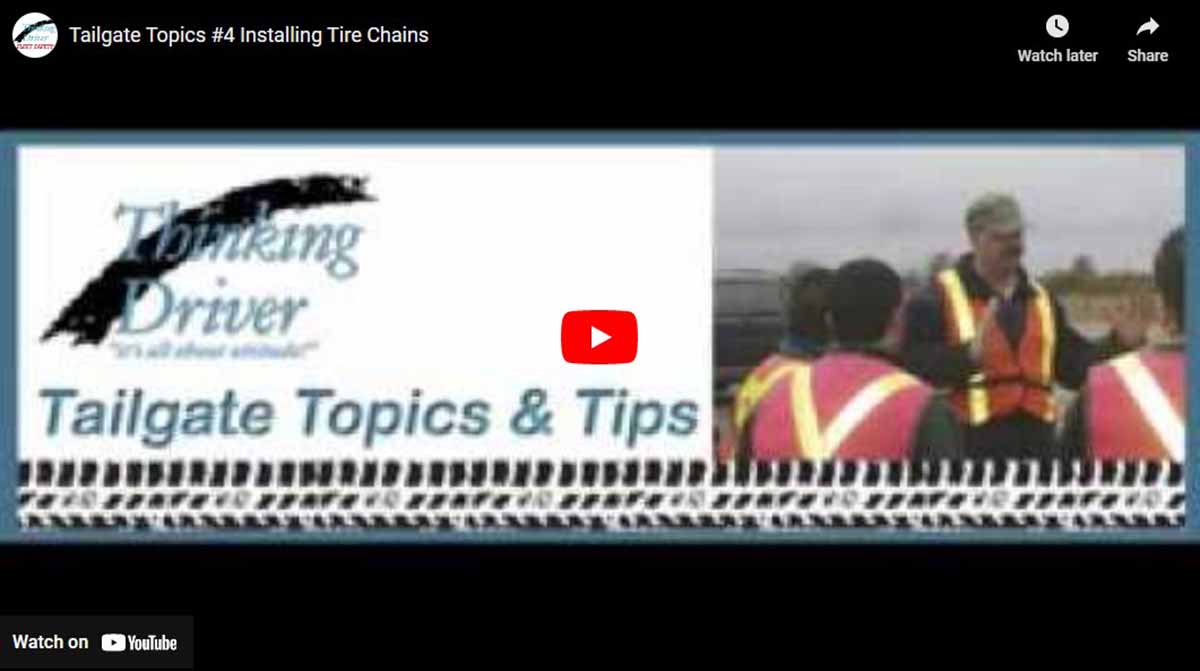Safety Meeting Planner & Agenda
Installing & Using Tire Chains Correctly!
Meeting Leader:
- Prepare in advance to make this meeting effective.
- Print and read over this entire agenda.
- Think about how you want to lead the meeting.
- Is there anything that is specific to your company or operation that you can include to personalize the information?
- Review the video for this session.
- Save the link to the video in your ‘Favourites’ folder on your browser for easy access.
- Open and then minimize the viewer just before the meeting to make the video introduction smooth.
Start Your Meeting!
Opening Statement:
If you drive in northern or high altitude areas with extreme winter conditions, you may use traction devices like tire chains to assist with control in winter but if you are not sure how to install them or drive with chains installed, you could be in for frustration and possibly vehicle damage or worse!
Questions for this Meeting:
Q: How many people here have used tire chains?
Discuss
Tire chains have been around for many years and are still a great choice to add a massive amount of traction in difficult conditions.
Many people have chains in their vehicle in winter but have not yet needed them and therefore have never installed them.
Q: When is the best time to learn how to install chains?
The best time to install chains on your vehicle, the first time, is BEFORE you need them. If you have a heated or at least dry garage or underground parking area to practise, this is best.
Tailgate Tips:
- The video that we will watch shortly, shows a common and popular style of light duty truck or car chains but yours could be different.
- Read the instructions first and follow them carefully to avoid vehicle damage or injury.
- When installing on the roadside, wear a reflective vest.
- Install the chains on the drive axle tires, on an all-wheel drive or four-wheel drive, install on the rear axle.
- The first steps are to lay out the chains and depending on the type,pass them behind the tire and then connect them at the top or lay them out in front of the tire and drive forward onto the chain before pulling up both ends and connecting at the top.
- It’s important to ensure that the chains are snug on the tire tread and the elastic straps crossing in front of the wheel are also snug.
- After installing the chains it’s a good idea to check the tension after driving a short distance.
- What is the maximum safe speed to drive with chains installed? 50 km/h or 30 mph is the maximum safe speed.
- If you are headed into the mountains and the roads are snowy and slick, before you approach a hill, install the chains in a safe area before you get stuck. Many highways provide a ‘chaining up’ area. Use this area and avoid the hazard of being stuck on a hill in a traveling lane trying to stay safe while installing your chains. Always wear a safety vest to be seen as you work.
- Remember to take the chains off in a safe area as soon as you are back on clear pavement to avoid damage to your vehicle, the chains and the roads.
- Once your trip is over, take the time to clean and dry the chains, inspect them, then spray them with an anti-rust coating and re-pack them to be ready for the next time that you need them.
- Always carry an emergency winter survival kit including a flashlight with extra batteries, a cell phone, blankets, water, snacks, gloves, boots, first aid kit, ice scraper, jumper cables, extra windshield washer fluid, a reflective vest and reflective markers or flares.
Summary:
- Learn to install your chains in advance and practise to ensure that you can do this in difficult conditions.
- Choose a safe place to install and remove the chains.
- Wear a safety vest while working outside the vehicle.
- Check for tension after driving a short distance.
- Keep your speed below 50 km/h or 30 mph.
- Clean and store chains properly after use.
Practical Challenge:
If your vehicles have tire chains, install them on a vehicle now as a team.









